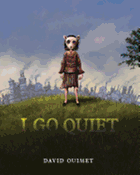
"Sometimes, I go quiet." A girl--hood up, slumping forward in resignation--walks to school, where "I don't know how I am supposed to be./ I am timid. I am small." One can hardly blame her. The paintings in I Go Quiet, by musician and debut author-illustrator David Ouimet, depict a gloomy, factory-evoking school where from the front of every child's desk hangs a dehumanizing white mask that the kids wear to some sort of assembly. Think Hogwarts by way of George Orwell. The girl feels set apart from everyone else: "I am different./ I am the note/ that's not in tune./ I go mousy. I go gray." Sure enough, while the girl's mask has pointy ears like the other kids', hers also has whiskers and a mouselike snout.
Why does I Go Quiet deserve to be on top of a stack of picture books about how reading is power and imagination is liberating? Consider, for example, a double-page spread showing the masked kids marching up and down the school's stairwells. The image resembles a cross section of a machine, each child a dead-eyed cog. Ouimet seems to be speaking (and painting) not about one person's anxiety but about a larger concern: the seductiveness of conformity, the threat of human obsolescence through automation. From the moment the girl arrives at school until she heads home that night, Ouimet's illustrations are dichromatic. But on her walk home ("When I am heard/ I will build cities/ with my words"), she sees a moonlit city in color. Later, from her bed, she looks out her window. Outside is a pair of white birds--a change from all the black ones that haunt prior pages, and perhaps a sign of hope. --Nell Beram, freelance writer and YA author

